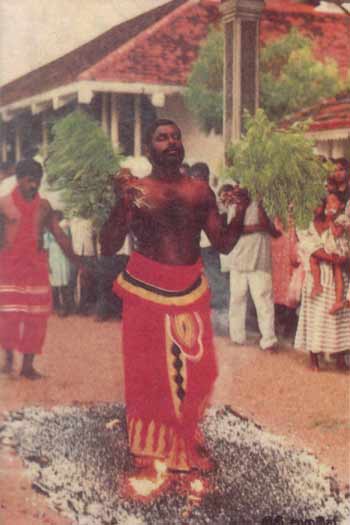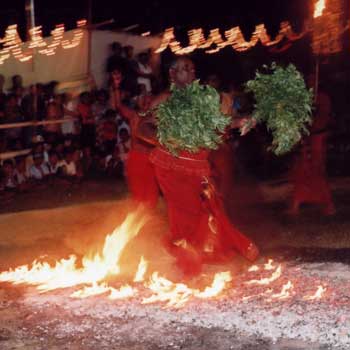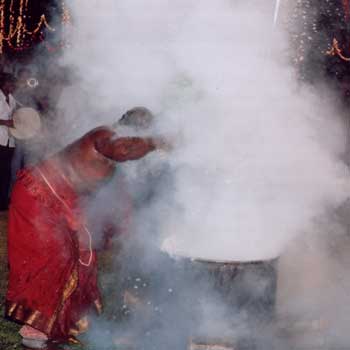|
| ||||||||
 Lankan Fire Walker wins International Prestige
As the first month of 1990 was ending four young Sri Lankan men left for Abu Dhabi from Katunayake International Airport without the usual fanfare and publicity? They were on their way to a town named Al Ain to participate in an international festival of dances, songs and magic performances. Al Ain annually attracts participants from many countries and their year's festival saw entries from 18 countries in the East and West. Over a fifty thousand people packed the open air theatre each night to witness the best performers from each of the countries which participated. Abu Dhabi has around 50,000 expatriate Sri Lankans who were prominent in the audience at Al Ain. But the expatriate Sri Lankan community was becoming anxious because their country's performers had not arrived in the first few days of the festival. Abu Dhabi citizens were asking the Sri Lankans. "Where are your dancers, aren't they corning for the show?" After several days the four young performers from Sri Lanka arrived. The group was led by Sarath M. Mohotti, an Able Seaman of the Sri Lanka Navy, and included G. Upul Chandrasekara, and Cyril Anthony. Overjoyed"When we arrived in Abu Dhabi we were overjoyed to meet thousands of Sri Lankans who had come to watch our performances. Several countries had already performed before the huge crowds and at last our turn came. I had the experience of taking part in fire walking from my eighth year under the guidance of my father M.M. Mohotti, who has been a pioneer in the fire walking ritual at Kataragama", said Mohotti who has returned recently from the Al Ain 1990 Festival. "The festival officials had made all the arrangements for our special show which included fire walking ritual, hanging on hooks piercing the back, gini sisila dance or the dance in which the performer actually took the flame into his mouth. The special aspect of my ritual is that I pour boiling milk on my body while I do the fire walking ritual. One of the Abu Dhabi people who was sceptical about what I was going to do came up to the pot of boiling milk and asked me whether I could put my hand into the boiling pot. I did as I was requested and the spectators, at least some of them, did not believe that the liquid was really at boiling point. The person then put his hand into the pot, only to get scalded severely and had to be rushed to a hospital writings in pain," Sarath Mohotti recalled. "The fire walking ceremony began with the usual offerings to the Kataragama deity and chanting of mantrams. The audience was spell bound as I started walking on the embers set aflame with paraffin thrown in as I walked on the embers. Even some Sri Lankans who had not seen actual fire walking on flames were watching the ritual in silence. Once I had performed ti ici applause broke spontaneously. At that moment I felt that I had done the Sri Lanka flag proud," said Sarath Mohotti, who had won the first place in the festival among performers from 18 countries. Sarath had put on his next performance of being suspended by hooks piercing the back for over 10 minutes before the enthralled audience. He was followed by G. Upali Chandrasekara ui the Sri Lanka Police Band who performed the 'Gini Sisila' dance in which the dancer literally took the flame of a torch into his mouth while performing the traditional ritual dance. Upali Chandrasekara is an exponent of traditional low country dance forms, Devol, Salu Paliya, Thelme, and mask dances such as Naga Raksha in which he too excels. Chandrasekara the "fire-eating young man" also won a certificate of high commendation from the Al Ain 90 festival committee. When asked how these two performers were able to resist the heat of fire and boiling milk, they said that the faith in deities and the mantrams they chanted before the performance helped them to resist flames. Pioneer"I have been trained from my eighth year in fire walking by my father who is a pioneer in this ritual", said Sarath Mohotti. "I don't walk on embers as other people do but walk through flames. I have implicit faith in the deity of Kataragama and the mantrams help me to perform the rituals," said Sarath Mohotti. "Gini Sisila is a dance form that is dedicated to the goddess Pattini and it is by invoking her blessings and by the mantrams that are chanted that one is able to take the flame of a torch into the mouth", said Upul Chandrasekara. Chandrasekara learnt the ritual dances under Sarath Pathirana, a well known dancer from Ingiriya from the age of 15 years. He has performed in France, Italy and Kuwait before he participated in the Al Ain 90 Festival. When asked what should be done to develop these traditional dance forms and rituals, the two performers said that Sri Lankan leaders and eminent persons should encourage traditional dancers and performers to go before the world as representatives of our cultural heritage. They also said that they would like to devote the rest of their lives to preserving and developing these dance forms and rituals which were distinctly Sri Lankan folk art forms. Editor's note: Mr. Mohotti's exceptional abilities have been acknowledged and documented in Sri Lanka's leading Sinhala and English newspapers. Television appearances and interviews with Mr. Mohotti appear regularly on Sri Lanka's television networks. Mr. Mohotti not only performs the extraordinary rite, but is also its most vigorous exponent in Sri Lanka and, increasingly, around the world. Since 1979 he has conducted public fire-walking rites abroad by invitation in Indonesia (1979), Japan (1990), Dubai (1991), Pakistan (2000) and India (2001). In recognition of Mr. Mohotti's lifetime achievements, the Ministry of Cultural Affairs of Sri Lanka in 2002 has cited Mr. Mohotti as a National Treasure. This article by Vijitha Nakkawita originally published in The Island (Colombo) in 1992. Contact information: 9, Vijayapura Kolonnawa, W.P. Sri Lanka Tel: +94 77-627-9152 or +94 77-906-1963 or +94 71-635-0309 or +94 77-914-8178 Or e-mail: kataragama@gmail.com |


